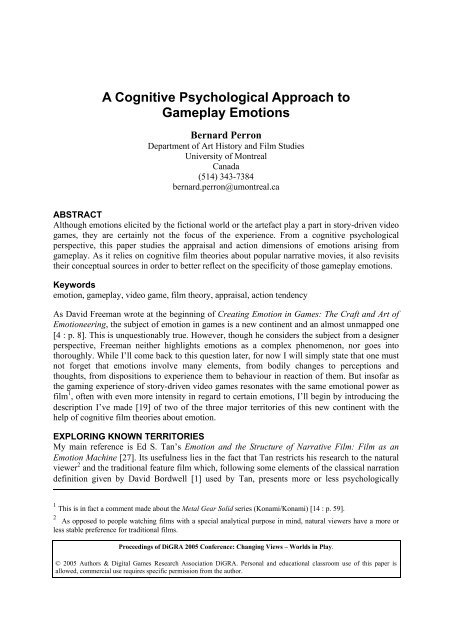A Cognitive Psychological Approach to Gameplay Emotions
A Cognitive Psychological Approach to Gameplay Emotions
A Cognitive Psychological Approach to Gameplay Emotions
Create successful ePaper yourself
Turn your PDF publications into a flip-book with our unique Google optimized e-Paper software.
A <strong>Cognitive</strong> <strong>Psychological</strong> <strong>Approach</strong> <strong>to</strong><br />
<strong>Gameplay</strong> <strong>Emotions</strong><br />
Bernard Perron<br />
Department of Art His<strong>to</strong>ry and Film Studies<br />
University of Montreal<br />
Canada<br />
(514) 343-7384<br />
bernard.perron@umontreal.ca<br />
ABSTRACT<br />
Although emotions elicited by the fictional world or the artefact play a part in s<strong>to</strong>ry-driven video<br />
games, they are certainly not the focus of the experience. From a cognitive psychological<br />
perspective, this paper studies the appraisal and action dimensions of emotions arising from<br />
gameplay. As it relies on cognitive film theories about popular narrative movies, it also revisits<br />
their conceptual sources in order <strong>to</strong> better reflect on the specificity of those gameplay emotions.<br />
Keywords<br />
emotion, gameplay, video game, film theory, appraisal, action tendency<br />
As David Freeman wrote at the beginning of Creating Emotion in Games: The Craft and Art of<br />
Emotioneering, the subject of emotion in games is a new continent and an almost unmapped one<br />
[4 : p. 8]. This is unquestionably true. However, though he considers the subject from a designer<br />
perspective, Freeman neither highlights emotions as a complex phenomenon, nor goes in<strong>to</strong><br />
thoroughly. While I’ll come back <strong>to</strong> this question later, for now I will simply state that one must<br />
not forget that emotions involve many elements, from bodily changes <strong>to</strong> perceptions and<br />
thoughts, from dispositions <strong>to</strong> experience them <strong>to</strong> behaviour in reaction of them. But insofar as<br />
the gaming experience of s<strong>to</strong>ry-driven video games resonates with the same emotional power as<br />
film 1 , often with even more intensity in regard <strong>to</strong> certain emotions, I’ll begin by introducing the<br />
description I’ve made [19] of two of the three major terri<strong>to</strong>ries of this new continent with the<br />
help of cognitive film theories about emotion.<br />
EXPLORING KNOWN TERRITORIES<br />
My main reference is Ed S. Tan’s Emotion and the Structure of Narrative Film: Film as an<br />
Emotion Machine [27]. Its usefulness lies in the fact that Tan restricts his research <strong>to</strong> the natural<br />
viewer 2 and the traditional feature film which, following some elements of the classical narration<br />
definition given by David Bordwell [1] used by Tan, presents more or less psychologically<br />
1 This is in fact a comment made about the Metal Gear Solid series (Konami/Konami) [14 : p. 59].<br />
2 As opposed <strong>to</strong> people watching films with a special analytical purpose in mind, natural viewers have a more or<br />
less stable preference for traditional films.<br />
Proceedings of DiGRA 2005 Conference: Changing Views – Worlds in Play.<br />
© 2005 Authors & Digital Games Research Association DiGRA. Personal and educational classroom use of this paper is<br />
allowed, commercial use requires specific permission from the author.
defined individuals − the principal causal agency − who straightforwardly struggle <strong>to</strong> solve clearcut<br />
problems or <strong>to</strong> attain certain goals. It also introduces solely temporary causal narrative gaps,<br />
gives information functionally necessary at a particular time, does not draw attention <strong>to</strong> itself as<br />
artefact and has an happy ending most of the time. As an opening postulate, Tan asserts : “[f]rom<br />
the perspective of the viewer, it could be said that what all natural viewers of the traditional<br />
feature film have in common is their desire <strong>to</strong> experience emotion as intensively and as<br />
abundantly as possible, within the safe margins of guided fantasy and closed episode”<br />
[27 : p. 39]. Identifying two sources of primary satisfaction, he then characterizes two relevant<br />
types of emotion.<br />
Rooted in the fictional world and the concerns addressed by that world, the first type of emotions<br />
are referred <strong>to</strong> as fiction emotions or F emotions [27 : p. 65]. 3 To begin with, though the viewer<br />
or gamer visits, via the power of their imagination, a fictional world where he or she runs no risk,<br />
this world does have an emotional impact. It is not the same thing <strong>to</strong> step in<strong>to</strong> the nightmarish<br />
city of Silent Hill, the corrupt neighbourhoods of Grand Theft Au<strong>to</strong>, or the fantasy worlds of<br />
Final Fantasy. But fiction emotions have above all <strong>to</strong> be defined as witness emotions because<br />
they are elicited by a controlled and invisible observer’s position. It is the protagonists’ concerns<br />
which are at stake. Since the situations in which those protagonists find themselves cannot be<br />
acted upon, we have <strong>to</strong> experience it with them. Fiction emotions are principally empathetic. The<br />
plot of s<strong>to</strong>ry-driven games unfolds beyond the control of the gamer, for the most part though cutscenes<br />
asides. For instance, nothing can be done about the murder of Max’s wife and daughter or<br />
the frame-up of which he is victim in Max Payne (Remedy/Rockstar Games, 2001), but you are<br />
lead <strong>to</strong> feel Max’s anger and <strong>to</strong> strive, with him, for revenge. You can only witness the betrayals<br />
of the two women Snake has relations with in Metal Gear Solid 3: Snake Eater<br />
(Konami/Konami, 2004) and feel sad with him, not <strong>to</strong> mention share his heartbreak that the death<br />
of one of those women elicits and feel compassion for the hero. 4<br />
Arising from the concerns related <strong>to</strong> the artefact, as well as stimulus characteristics based on<br />
those concerns, Tan’s second type of emotion is called artefact emotions or A emotions<br />
[27 : p. 65]. As soon as the viewer or gamer is aware, no matter how fleetingly, of artistry and<br />
manipulation, the object of the emotion is not the fictional world anymore, but the film or the<br />
game as a man-made artefact. One wouldn’t expect less from artefacts produced by an industry<br />
based on fast-changing computer technology. Video game his<strong>to</strong>ry is peppered with technological<br />
innovations and the groundbreaking computer-generated imagery that create this type of<br />
emotions. The aesthetic of video game has much <strong>to</strong> do with an “aesthetic of as<strong>to</strong>nishment” 5 . We<br />
can certainly feel wonder crossing dazzling 3D landscapes or moving along with the real-time<br />
3 Widening his considerations in a later paper, Tan talks about R-emotions, that is emotions elicited by elements of<br />
the represented world [25].<br />
4 When Freeman talks for instance in Creating Emotion in Games about making major NPCs interesting, giving<br />
them emotional depth and complexity through the game, writing interesting and deep lines of dialogue, making<br />
game plots interesting, using symbols, or using opening, pre-rendered and in-game cinematics <strong>to</strong> suck the gamer in<strong>to</strong><br />
the game, he is talking about fiction emotions.<br />
5 An expression of Tom Gunning about the early cinema. See also Andrew Mactavish’s article : “Technological<br />
Pleasure : The Performance and Narrative of the Technology in Half-Life and Other High-Tech Computer Games”<br />
[18].<br />
2
lighting of the Splinter Cell games. Following the example of Metal Gear Solid 3: Snake Eater,<br />
we can be surprised by a sudden twist of the plot and reflect upon the intricacy of the telling of<br />
the s<strong>to</strong>ry. 6 But in a game, we can be very displeased by a bad game design, as we can have<br />
admiration for the specific act of puzzle construction. We can be in awe in front of the physics<br />
engine, say of Half-Life 2 (Valve Software/Vu Games, 2004).We can equally as<strong>to</strong>nished by a<br />
counterattack of NPCs that we’ve never seen before. For Tan, there is a likelihood that more<br />
intense the emotion may be, the greater one will realize that this is a special experience and be<br />
aware that one is in front of an artefact. This is a situation in which the simulation’s of video<br />
games often puts us. Has it not been stated that video game art is the art of simulation ?<br />
APPRAISING THE NEW FIELD<br />
Without doubt fiction and artefact emotions play a role in s<strong>to</strong>ry-driven games. But they are<br />
certainly not the main part of the experience. Needless <strong>to</strong> say, we are playing for gameplay<br />
emotions 7 or G emotions, the emotions arising from our actions in the game − mostly in the<br />
game-world in the case of narrative games − and the consequent reactions of the game(-world). 8<br />
To paraphrase Frijda [5], the different pleasures (and displeasures) we have when playing a game<br />
are the most elementary of our emotional processes. As Nicole Lazzaro’s research shows, over<br />
thirty emotions − although they are no all introduced in her abstract − may be elicited by<br />
gameplay, completely separated from those elicited by s<strong>to</strong>ry [17]. The impact of gameplay is,<br />
currently, scrutinized by empirical studies of affective gaming that investigate the states of<br />
arousal of the gamer. As well, notions such as “adaptive gameplay” call attention <strong>to</strong> the way<br />
video games are meant <strong>to</strong> respond <strong>to</strong> the gamer’s emotional states [10,11, 24] 9 . Since it is hard <strong>to</strong><br />
look at emotions from all angles, it is from a cognitivist perspective that I wish <strong>to</strong> make my<br />
contribution <strong>to</strong> the study of gameplay emotion. Basically, I want <strong>to</strong> start <strong>to</strong> examine the appraisal<br />
and action dimensions of those emotions. As a comparative analysis of film and video game<br />
inevitably leads us <strong>to</strong> reflect on the specificity of the latter, which Torben Grodal’s “Video<br />
Games and the Pleasure of Control” illustrates remarkably well [13], it also prompts us <strong>to</strong> revisit<br />
theoretical sources in order <strong>to</strong> better apply them.<br />
S<strong>to</strong>ry-driven games meet the elements of the above-mentioned description of classical narration.<br />
They are indeed avatar-centered and therefore chiefly elicit pro<strong>to</strong>typical emotions which are<br />
intentional, object-oriented and action-oriented. <strong>Emotions</strong> are as much processes as states.<br />
“[E]motional reactions develop over time and usually consist of sequences of emotional<br />
reactions” [6 : p. 382]. <strong>Emotions</strong> are structured, and wax and wane according <strong>to</strong> rules. They are<br />
functional in the way they regulate the interaction between the individual and the environment,<br />
whether it is real or virtual. While Tan’s “filmic emotion machine” remains my principal<br />
6 So when Freeman recommends <strong>to</strong> “make both in-game and pre-rendered cinematics more artful and, thereby, more<br />
emotionally complex and powerful” [4: p. 389], making the gamer unable <strong>to</strong> predict the end of a cinematic, he is<br />
also pointing <strong>to</strong>ward artefact emotions.<br />
7 As opposed <strong>to</strong> game emotions that would underline a production coming from the game and would not give<br />
emphasis on the personal experience of the gamer.<br />
8 In my opinion, it’s only when Freeman [4] talks about the choice of actions given <strong>to</strong> the gamer that he’s really<br />
pointing <strong>to</strong> gameplay emotions.<br />
9 Besides, papers on those research are part of the program of the DIGRA 2005 Conference.<br />
3
eference, his main one is Nico H. Frijda work, principally his book The <strong>Emotions</strong> [9]. 10 For<br />
Frijda, and this is part of the twelve laws of emotions he enunciates [7], emotions arise in<br />
response <strong>to</strong> the meaning structures of a given situation; thus different emotions arise in responses<br />
<strong>to</strong> different meaning structures. <strong>Emotions</strong> arise, what’s more, in response <strong>to</strong> events that are<br />
important <strong>to</strong> the individual’s goals, motives and concerns. There is a more or less enduring<br />
disposition <strong>to</strong> prefer particular states of the world. Frijda’s thought lies within the predominant<br />
cognitive appraisal theory of emotions.<br />
From a cognitivist perspective, cognition and emotions work <strong>to</strong>gether. <strong>Emotions</strong> are determined,<br />
as it was just noted, by the interaction between a given situation and an individual. They will<br />
differ according <strong>to</strong> the ways the situational meanings might be assessed. As Frijda states, and<br />
also Lazarrus and Folkman [16], there are two types of cognitive appraisal. In a primary<br />
appraisal, the situation is evaluated according <strong>to</strong> a person’s well-being. A situation that is not<br />
relevant for an individual is not likely <strong>to</strong> elicit an emotion. A benign-positive or stressful<br />
situation will be characterized as pleasant or unpleasant. Then, in secondary appraisal, it is what<br />
might be done or can be done that is assessed. The process takes in<strong>to</strong> account the available<br />
coping options, their range and their effectiveness. In video game, Torben Grodal has noticed,<br />
ever so pertinently, that “[i]t is the player’s evaluation of his own coping potential that<br />
determines whether [a] confrontation with a monster will be experienced as fear (if the<br />
evaluation of his coping potential is moderate), despair (if he feels that he has no coping<br />
potentials), or triumphant aggression (if he feels that he is amply equipped for the challenge).<br />
This entails that the emotional experience will vary over time, due <strong>to</strong> the learning processes<br />
leading <strong>to</strong> a change in coping potentials” [12 : p. 150]. It is worth reiterating Grodal’s consequent<br />
conclusion : “Video games therefore simulate emotions in a form that is closer <strong>to</strong> typical real life<br />
experiences than film: emotions are motiva<strong>to</strong>rs for actions and are labelled according <strong>to</strong> the<br />
player’s active coping potentials” [13 : p. 201]. And on the basis of new information from the<br />
environment, finding ammos or a health kit for example, the situation or confrontation will be<br />
reappraised, and the meanings attached <strong>to</strong> it will be changed.<br />
In appraisal theory, different emotions correspond with different appraisal structures. Although<br />
appraisal determinants may vary in some respects, some remain important consistently, and give<br />
us more insights as <strong>to</strong> the causes of emotions 11 :<br />
- Motive-Consistent versus Motive-Inconsistent. This is the fundamental distinction<br />
between positive and negative emotions. A positive emotion thus occurs when a situation<br />
is consistent with the person’s goals, desires, intentions, and motives. Hope, joy, relief,<br />
liking and, and pride are positive emotions. Fear, sadness, distress, frustration, disgust,<br />
dislike, anger, contempt, regret, guilt and shame are negative ones. However, it is<br />
possible <strong>to</strong> connect the two opposites. We play a survival horror game for the many<br />
pleasures of being scared. There is nothing really bad about feeling a bite of frustration<br />
in front of a puzzle we must solve or an obstacle we must overcome.<br />
10 Tan and Frijda even wrote a paper <strong>to</strong>gether about “Sentiment in Film Viewing” [26].<br />
11 I’m following here Per Persson’s application [21] of the Roseman, An<strong>to</strong>nio and Jones’s structure of the emotion<br />
system [22].<br />
4
- Expectedness versus Unexpectedness of the Event. Appraised independent of motives,<br />
surprise is elicited by unexpectedness, and it is related <strong>to</strong> novelty and unfamiliarity.<br />
- Circumstance-Caused versus Other-Caused or Self-Caused Events. The agent causing a<br />
given situation <strong>to</strong> emerge is critical <strong>to</strong> the appraisal of it. Joy is more circumstancecaused,<br />
while liking is caused by another person and pride by our own action. In a s<strong>to</strong>rydriven<br />
video game (as opposed <strong>to</strong> online games where you meet people), it is improbable<br />
we will feel liking per se. You may get angry at the actions of the NPCs (other-caused).<br />
However, the situation might be proved more complex. Immersed in the game, your may<br />
be frustrated by the circumstance leading <strong>to</strong> a failure and hope for a better outcome<br />
(circumstanced-caused). But if you are thinking about the system behind the fictional<br />
world or if you relate <strong>to</strong> the computer as Other (as do some sociological studies), it will<br />
always become an other-caused situation. When you succeed, you are pride of yourself<br />
(self-caused).<br />
- Believed Certainty versus Uncertainty of the Event. Believing in the probability of an<br />
upcoming event explains the difference between joy and relief that are certain, and hope<br />
(positive) and fear (negative) that are not.<br />
- Appetitive versus Aversive. This is another fundamental distinction. We want <strong>to</strong> obtain,<br />
pursue or keep something pleasurable (joy), and discard a thing inconsistent with our<br />
desire or concerns (distress, disgust, contempt and shame).<br />
- High versus Low Control Potential. An important situational appraisal is whether we<br />
believe we can change the course of an event, res<strong>to</strong>re it or undo it. Frustration arises<br />
because we can control the situation but are never able get <strong>to</strong> the end. Otherwise, it<br />
unlikely that a s<strong>to</strong>ry-driven video game in which I can/have <strong>to</strong> reinvest my action or the<br />
paths I’ve chosen would bring regret at the gameplay level. Because regret is elicited<br />
when I cannot redo something (for instance, you can regret you did decline in the past the<br />
invitation <strong>to</strong> become a member of a good Counter-Strike Clan).<br />
But emotions do not have only an appraisal dimension. They also have an action one.<br />
READY FOR ACTION<br />
In Film Structure and the Emotion System, Greg Smith criticizes Tan’s choice <strong>to</strong> limit himself <strong>to</strong><br />
the work of Frijda in order <strong>to</strong> account for filmic emotions [23]. His criticism is certainly correct<br />
with regard <strong>to</strong> the notion of action tendency which is fundamental <strong>to</strong> Frijda’s theory. Indeed,<br />
emotions are action tendencies. They can be defined as “modes of relational action readiness,<br />
either in the form of tendencies <strong>to</strong> establish, maintain, or disrupt a relationship with the<br />
environment or in the form of mode of relational readiness as such” [9 : p. 71], or “be conceived<br />
of as plans or programs <strong>to</strong> achieve such ends, which are put in a state of readiness” [9 : p. 75].<br />
Emotional action tendencies are felt as impulses and urges <strong>to</strong> act in one way or another until an<br />
emotional episode is closed due <strong>to</strong> a change of situation. They therefore assign precedence <strong>to</strong> the<br />
control of action and the information processing that goes with it (what Frijda calls control<br />
precedence).<br />
The application of emotional action tendency <strong>to</strong> film viewing reveals, as matter of fact, the<br />
inevitable conclusion that this tendency is only virtual. What’s more, in cinema, all you can see<br />
is on the screen and your gaze is controlled by mise-en-scene and montage. “Thus, in effect, says<br />
Tan, the action reper<strong>to</strong>ire of the viewer in his or her capacities of specta<strong>to</strong>r <strong>to</strong> the fictional event<br />
5
is empty” [27 : p. 75]. You cannot run <strong>to</strong> help the President’s daughter when she is threatened by<br />
Russian terrorists in Air Force One (Wolfgang Petersen, 1997). But this doesn’t mean that the<br />
emotional experience felt through the actions of the fictional characters cannot be intense.<br />
However that may be, and I’m following Smith’s reasoning here, since action tendencies are<br />
crucial <strong>to</strong> the definition of emotion and that actual tendencies are more important than virtual<br />
ones, Tan sets the notion of “interest” as the central emotional mechanism in film viewing : “[i]n<br />
the case of interest, the action tendency is real, unlike so many other affects evoked by film”<br />
[27 : p. 118]. Interest is defined as an elaboration akin <strong>to</strong> problem solving, “a mental activity that<br />
lies somewhere between free association or fantasy on the one hand and a strictly prescribed<br />
process of inference controlled by the text, on the other hand” [27 : p. 90-91]. Interest is based<br />
on concerns and on the situational meaning structure of the characters’ action in the fictional<br />
world. It displays a “strong control precedence” that refers <strong>to</strong> the fascination, enthrallment,<br />
tension and absorption. For those reasons, it exhorts the viewer <strong>to</strong> pay attention <strong>to</strong> detail, <strong>to</strong><br />
investigate the plot for clues, <strong>to</strong> learn more about the s<strong>to</strong>ry, and <strong>to</strong> anticipate what will happen<br />
next. To maximize the interest of the viewer as regard <strong>to</strong> progress made <strong>to</strong>ward closure and the<br />
preferred final situation, the narrative has <strong>to</strong> find a perfect balance between frustration and<br />
reward.<br />
Interest as emotion is, of course, as significant in s<strong>to</strong>ry-driven games. And, given that action<br />
tendencies are not virtual, it takes things a step further (even if it is enacted in a virtual gameworld).<br />
Between free association and prescribed process of inference, the gamer has <strong>to</strong> make his<br />
or her avatar explore the game world in order <strong>to</strong> find clues about the plot, about “the prestructured<br />
but embedded [narrative] within the mise-en-scene awaiting discovery” [15 : p. 126].<br />
He or she may also traipse around if he or she wishes. In Jenkins’ terms, this would then be the<br />
gamer own “unstructured and controlled narrative”, a narrative that can elicit artefact emotions<br />
should we note (as procrastination leads us <strong>to</strong> wonder at the artistry behind the creation of the<br />
fictional world). But the gamer still has <strong>to</strong> pursue the avatar’s goals or the concerns set by the<br />
game, that is for example <strong>to</strong> save the President’s daughter in Resident Evil 4 (Capcom/Capcom,<br />
2005). To do so, he or she has <strong>to</strong> straightforward struggle <strong>to</strong> solve cleat-cut problems, whether it<br />
is a riddle, or how <strong>to</strong> dodge or kill monsters. Following Lazzaro’s four keys <strong>to</strong> the gameplay<br />
emotional experience, and depending of how the space is contested and how the gamer appraises<br />
it, this will be “hard fun” (<strong>Emotions</strong> from Meaningful Challenges, Strategies, and Puzzles)<br />
and/or “easy fun” (Grab attention with Ambiguity, Incompleteness, and Detail).<br />
Tan’s “interest theory” rests <strong>to</strong> a large degree on the progress made in the direction of closure<br />
and on the uncertainty about the final situation. For the most part, the cognitive and affective<br />
investments in the fiction take the form of anticipations which counterpart the antagonistic effect<br />
of the narrative. In his explanation, Tan refers briefly <strong>to</strong> a notion put forward by Noel Carroll, i.e.<br />
erotetic narration [2, 3]. 12 Applied <strong>to</strong> linear narrative structure of popular movies, this is a model<br />
based on the logic of questions and answers. To various degrees, each scene asks a question that<br />
articulates the narrative possibilities and that the movie will go on <strong>to</strong> answer. Whereas the end<br />
12 We must also say that the “curiosity theory” developed by Carroll about the horror genre [2] has many<br />
similarities with Tan’s interest one. Video game literally involves a “play of ratiocination” and the “drama of<br />
corridors” that Carroll talks about applies quite well <strong>to</strong> the maze structure of s<strong>to</strong>ry-driven video games, be a survival<br />
horror game or not.<br />
6
ings out an answer <strong>to</strong> the macro-question(s) of the movie, there are, beforehand, a large<br />
number of micro-questions <strong>to</strong> be answered. Those micro-questions connect fictional event <strong>to</strong><br />
fictional event and slow down progress <strong>to</strong>ward the end. Erotetic narration is also an elaboration<br />
akin <strong>to</strong> problem solving. Yet again, this theorization makes even better sense regarding video<br />
games. If the viewer is a question-former according <strong>to</strong> Carroll, the gamer has therefore <strong>to</strong> be seen<br />
as a answer-maker, a decision-maker, a problem-solver. Leaving narration aside and considering<br />
the game itself, it is thus possible and appropriate <strong>to</strong> talk about erotetic gameplay. <strong>Gameplay</strong> is<br />
about micro-questions that the gamer must answer, about micro-objectives that he or she must<br />
attain. The difficulty of these varies, something boss fights display. Games like Tom Clancy’s<br />
Splinter Cell (Ubisoft/Ubisoft, 2002) illustrate this process perfectly. Sam Fisher always receives<br />
objectives at the beginning of and during a level via his OPSAT. He has <strong>to</strong> find ways <strong>to</strong> infiltrate<br />
various facilities, ways <strong>to</strong> meet contacts, ways <strong>to</strong> cross protected areas, ways <strong>to</strong> avoid taking<br />
people’s life and ways <strong>to</strong> kill others, ways <strong>to</strong> retrieve, access, collect, desactivate or destroy<br />
items, etc. The constraints the gameplay micro-questions place on the gamer’s actions are <strong>to</strong> be<br />
overcome within the range of possible moves Sam Fisher can perform. All those micro-goals or<br />
concerns will eventually enable Sam Fisher <strong>to</strong> save the U.S. from a Russian terrorist’s threat<br />
(happy ending), that is <strong>to</strong> answer the macro-question of the game. In spite of its linear<br />
progression and many pre-defined answers or options, erotetic gameplay can be “hard fun”.<br />
Frijda notes : “Pleasure in successful goal achievement extends <strong>to</strong> any goal-directed action that is<br />
successfully performed, when such performance is not taken for granted and perceived as a<br />
challenge. This is the domain of mastery pleasures, <strong>to</strong> which most or all activities lead <strong>to</strong> flow or<br />
and optimal experience belong” [5 : 81]. It is the gamer’s progress and achievements which are<br />
rewarded.<br />
<strong>Gameplay</strong> emotions arise from the interactions of the gamer with the game(-world). This brings<br />
us back <strong>to</strong> the questions of action readiness and action tendency. If interest is the only real action<br />
tendency in film, it is not the case in video game where many controls can lead <strong>to</strong> action.<br />
Opening an instruction guide confirms this easily. Game controls allow a reper<strong>to</strong>ire of in-game<br />
actions : from staying still <strong>to</strong> running, from crouching <strong>to</strong> jumping, from throwing punches <strong>to</strong><br />
shooting guns, from looking <strong>to</strong> maps <strong>to</strong> accessing inven<strong>to</strong>ries, etc. But inasmuch as you can<br />
make your avatar act, you have <strong>to</strong> make him takes action. If not, there will be no game.<br />
Otherwise, as I’ve often stressed with regards survival horror games, it is certainly not the avatar<br />
that is meant <strong>to</strong> be scared or have emotions, but rather the gamer [19]. The avatar, incidentally,<br />
generally stays expressionless, whatever the situation. We saw that emotions depend on the<br />
gamer’s appraisal of a given game situation. This individual appraisal will consequently produce<br />
subjective emotional reactions. However subjective the emotions might be, several of them 13<br />
“can be unambiguously defined in terms of particular forms of action readiness, [and] of some<br />
form of action tendency or some form of activation or lack of thereof” [7 : 351]. In The <strong>Emotions</strong><br />
[9 : p. 88], Frijda presents a table (2.1) containing emotions with relational action tendencies,<br />
activation modes and functions. From this outline, we can characterize some pro<strong>to</strong>typical<br />
gameplay emotions:<br />
- Interest is then seen as a tendency <strong>to</strong> attend, <strong>to</strong> paid attention, <strong>to</strong> observe well and<br />
understand the situation.<br />
13 There is an underlining debate here about “basic emotions” that I do not want <strong>to</strong> enter in<strong>to</strong>, and that I could not<br />
grasp anyway in all its entirety and fine distinctions because of my background.<br />
7
- Enjoyment is a <strong>to</strong>nic reaction that prompts <strong>to</strong> be-with, <strong>to</strong> interact and <strong>to</strong> engage in<br />
consumma<strong>to</strong>ry activities. As we know, an enjoyable game session is hard <strong>to</strong> leave.<br />
- Worry has the tendency <strong>to</strong> make us turn <strong>to</strong>ward an object one is thinking about. ICO<br />
(SCEI/SCEA, 2001) succeeds perfectly <strong>to</strong> make me worried about the princess Yorda. I<br />
thought about her all the time after I left her behind.<br />
- Fear is manifested by the impulse <strong>to</strong> move, <strong>to</strong> run away. In a survival horror game like<br />
Resident Evil 4, I’ll avoid a threatening monster in order <strong>to</strong> protect myself.<br />
- Surprised or shocked by the apparition of one of the monsters, I’ll be interrupted, will<br />
freeze in order <strong>to</strong> reorient myself.<br />
- Anger has an agonistic tendency. It urges one <strong>to</strong> move against. Its function is <strong>to</strong> regain<br />
control. So when I get mad at my opponents, I’ll assault them with my best weapon in<br />
order <strong>to</strong> remove them as obstructions.<br />
- Frustration, the feeling of boiling inside, has also a tendency <strong>to</strong> move in an antagonistic<br />
way. I become short tempered when I’m not able <strong>to</strong> achieve an objective, or if I’m forced<br />
<strong>to</strong> redo the same actions all over again. For example, I became really upset by the 14 th<br />
mission of XIII (Ubisoft/Ubisoft, 2003). Not being able <strong>to</strong> save the game after a hard<br />
battle, finally vic<strong>to</strong>rious, against the mad Doc<strong>to</strong>r Johansson at Plain Rock Asylum, I was<br />
annoyed by the fact that, afterward, I still had <strong>to</strong> face more guards who killed me before I<br />
could escape. This death brought me back <strong>to</strong> a point before the aforementioned difficult<br />
boss fight.<br />
As those few observations demonstrate, a close examination of the action tendencies shows<br />
remarkable insight in<strong>to</strong> the problem of gameplay emotions.<br />
STILL IN THE MOOD FOR FUN<br />
This paper intended <strong>to</strong> map in a bit more detail the new continent of emotions in games. But one<br />
will undoubtedly have guessed that the task is not finished, even if I had limited myself <strong>to</strong> s<strong>to</strong>rydriven<br />
video games. Along with empirical studies, cognitive psychological approaches <strong>to</strong><br />
gameplay emotions need <strong>to</strong> draw upon techniques able <strong>to</strong> probe <strong>to</strong> greater depths. Because s<strong>to</strong>rydriven<br />
games are dense information emotional world. They use multiple emotion cues <strong>to</strong> elicit<br />
the proper emotional experience. Thus, the relation between fiction and gameplay emotions will<br />
have <strong>to</strong> be better examined. Moreover, emotions, said <strong>to</strong> last seconds or minutes, have <strong>to</strong> be<br />
distinguished from emotion episodes which are continuous and coherent series of emotions, and<br />
from moods that can last for a longer period of time. Since the playing of a game goes on for<br />
many hours, and video games can be seen as “mood managers” allowing the gamer <strong>to</strong> participate<br />
in a self-controlled arousing experience [13 : p. 209], those affective states without an object are<br />
important <strong>to</strong> study. The mood-cues approach of Greg Smith becomes a great theoretical <strong>to</strong>ol of<br />
analysis. For Smith, mood is the primary set of orienting emotions states that can be elicited by<br />
various cues. It orients us <strong>to</strong>ward experiencing specific emotions [23 : p. 38]. The fearful mood<br />
of a survival horror games such as Resident Evil 4 puts, for example, the gamer in emotional<br />
alert and prepares him/her <strong>to</strong> experience burst of fear. There is certainly a link <strong>to</strong> trace between<br />
the notion of mood and the way the gamer gets emotionally immersed in games. To our great<br />
pleasure, this deserves further study.<br />
REFERENCES<br />
1. Bordwell, D. Narration in the Fiction Film. University of Wisconsin Press, Madison, 1985.<br />
2. Carroll, N. The Philosophy of Horror or Paradoxes of the Heart, Routledge, New York, 1990.<br />
8
3. Carroll, N. Mystifying Movies. Fads & Fallacies in Contemporary Film Theory, Columbia University<br />
Press, New York, 1988.<br />
4. Freeman, D. Creating Emotion in Games: The Craft and Art of Emotioneering, New Riders,<br />
Indianapolis, 2004.<br />
5. Frijda, N. H. “The nature of pleasure,” in J. A. Bargh and D. K. Apsley (Eds.), Unraveling the<br />
Complexities of Social Life: A Festschrift in Honor of Robert B. Zajonc, American <strong>Psychological</strong><br />
Association, Washing<strong>to</strong>n, DC, 2002, pp. 71–94.<br />
6. Frijda, N.H. “Moods, <strong>Emotions</strong> Episodes, and <strong>Emotions</strong>,” in M. Lewis and J.M. Haviland-Jones (Eds.),<br />
Handbook of <strong>Emotions</strong> (1st ed.), Guilford Press, New York, 1993, pp. 381-403.<br />
7. Frijda, N.H. “The Laws of Emotion,” American Psychologist, vol. 43, no. 5 (1988), pp. 349-358.<br />
8. Frijda, N.H. “Emotion, emotion structure, and action tendency,” Cognition and Emotion, vol. 1, no. 2<br />
(1987), pp. 115-143.<br />
9. Frijda, N.H. The <strong>Emotions</strong>, Cambridge University Press, Cambridge, 1986.<br />
10. Gilleade, K. M., and Dix, A. “Using Frustration in the Design of Adaptive Videogames,” Proceedings<br />
of ACE 2004, Advances in Computer Entertainment Technology, ACM Press (2004).<br />
Available at .<br />
11. Gilleade, K.M., and Allanson, J. “A Toolkit for Exploring Affective Interface Adaptation in<br />
Videogames,” Proceeding of HCI International 2003, vol. 2, LEA, New Jersey (2003), pp. 370-374.<br />
Available at .<br />
12. Grodal, T. “S<strong>to</strong>ries for Eye, Ear, and Muscles: Video Games, Media, and Embodied Experiences,” in<br />
M.J.P. Wolf and B. Perron (Eds.), The Video Game Theory Reader, Routledge, New York, 2003, pp.129-<br />
155.<br />
13. Grodal, T. “Video Games and the Pleasure of Control,” in D. Zillmann and P. Vorderer (Eds.), Media<br />
Entertainment: The Psychology of Its Appeal, Lawrence Erlbaum Associates, Mahwah, N.J., 2000, pp.<br />
197-213.<br />
14. Hanson, M. “Player vs. Specta<strong>to</strong>r. Game as Cinema, FMV, Cinematics, and Machinima”, The End of<br />
Celluloid: Film Futures in the Digital Age, Ro<strong>to</strong>vision, London, 2004, pp. 55-67.<br />
15. Jenkins, H. “Game Design as Narrative Architecture,” in N. Wardrip-Fruin and P. Harrigan (Eds.)<br />
First Person: New Media as S<strong>to</strong>ry, Performance, and Game, MIT Press, Cambridge, 2004, pp. 118-130.<br />
16. Lazarus. R.S., & Folkman, S. Stress, Appraisal and Coping, Springer Publishing Company Inc., New<br />
York, 1984.<br />
17. Lazzaro, N. “Why We Play Games: Four Keys <strong>to</strong> More Emotion Without S<strong>to</strong>ry”. Available at<br />
.<br />
18. Mactavish, A. “Technological Pleasure : The Performance and Narrative of the Technology in Half-<br />
Life and Other High-Tech Computer Games”, in G. King and T. Krzywinska (Eds.), ScreenPlay.<br />
Cinema/videogames/interfaces, Wallflower, London, 2002, pp. 33-49.<br />
19. Perron, B. “Jeu vidéo et émotions”, in S. Genvo (Ed.), Le game design de jeux vidéo. Approches de<br />
l’expression vidéo-ludique, Éditions Mnémos, Paris, <strong>to</strong> be published in 2005.<br />
20. Perron, B. “Sign of a Threat : The Effects of Warning Systems in Survival Horror Games”, COSIGN<br />
2004 Proceedings, University of Split (2004), pp. 132-141. Available at<br />
.<br />
21. Persson, P. Understanding Cinema : A <strong>Psychological</strong> Theory of Moving Imagery, Cambridge<br />
University Press, Cambridge, 2003.<br />
9
22. Roseman, I. J., An<strong>to</strong>niou, A. A., & Jose, P. E. “Appraisal determinants of emotions: Constructing a<br />
more accurate and comprehensive theory,” Cognition and Emotion, vol. 10, no. 3 (1996), pp. 241-277.<br />
23. Smith, Greg M. Film Structure and the Emotion System, Cambridge University Press, Cambridge,<br />
2003.<br />
24. Sykes, J., & Brown, S. “Affective gaming: Measuring emotion through the Gamepad”. CHI 2003:<br />
New Horizons (2003), pp. 732-733. Available at .<br />
25. Tan, E.S. “Emotion, Art, and The Humanities,” in M. Lewis and J.M. Haviland-Jones (Eds.),<br />
Handbook of <strong>Emotions</strong> (2nd ed.), Guilford Press, New York, 2000, pp. 116-134.<br />
26. Tan, E.S., and Frijda N. H. “Sentiment in Film Viewing,” in G. Smith and C. Plantinga (Eds.),<br />
Passionate Views: Film, Cognition and Emotion, Johns Hopkins University Press, Baltimore, 1999, pp.<br />
48-64.<br />
27. Tan, E.S. Emotion and the Structure of Narrative Film: Film as an Emotion Machine, Erlbaum,<br />
Mahwah, NJ, 1996.<br />
10













